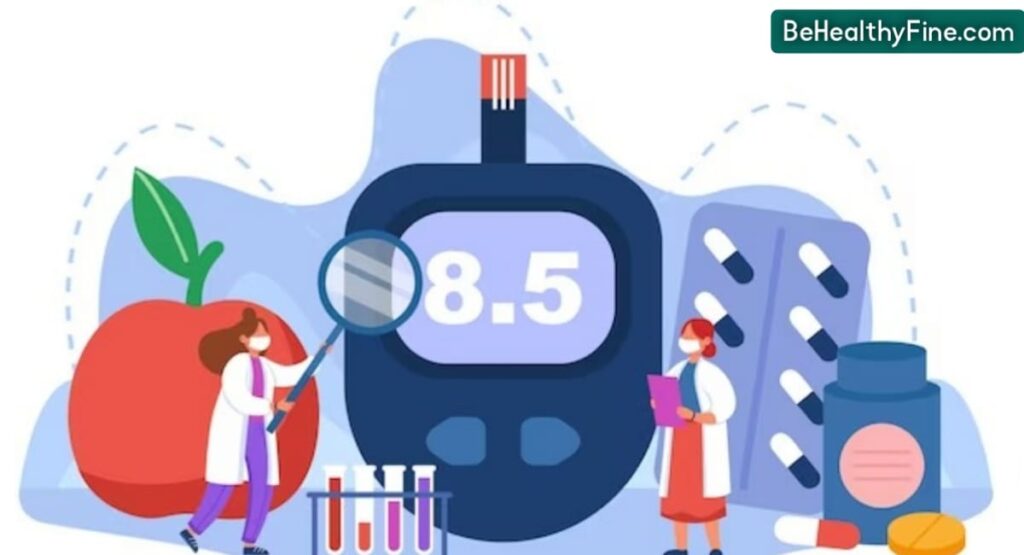Having diabetes comes with a lot of difficulties, but one of the trickiest parts is how it can affect your eyes and give you head pain. In this article, we’ll talk about the informative reasons about eye problems caused by diabetes.
Like diabetic retinopathy and neuropathy, and how they can lead to eye pain and headaches. Plus, we’ll share what you can do to keep your eyes and overall health in well being. keep read this full and share with your friends. Let’s Understand Diabetes Eye Pain and Headache Signals
Diabetic Retinopathy: The Silent Danger for the Eyesight
Diabetic retinopathy is a critical diabetes complication impacting the eyes. When blood sugar levels stay high for a long time, they harm the blood vessels in the retina, which is the sensitive part at the back of the eye.
This damage leads to vision issues. In later stages, it can even cause severe eye pain and headaches. The condition worsens gradually, starting with mild vision problems and potentially resulting in blindness if not treated. Symptoms include blurry vision, seeing spots or floaters, and having trouble seeing in low light.
Regular eye check-ups are crucial to catch diabetic retinopathy early. It’s also important to control blood sugar well and make lifestyle changes to manage it effectively.
Neovascular Glaucoma:
Neovascular glaucoma is a severe type of glaucoma that happens when abnormal blood vessels grow in the iris (the colored part of the eye) and in the eye’s drainage angle.
In diabetes, this often occurs because of diabetic retinopathy, where these abnormal blood vessels can block the eye’s drainage system, leading to increased pressure inside the eye. This high pressure can cause severe eye pain and headaches. If left untreated, neovascular glaucoma can lead to permanent vision loss.
Treatment usually involves using medications, laser therapy, and sometimes surgery to control the eye pressure and protect vision. Regular check-ups are crucial to catch any issues early and prevent complications. Checkout this [Effective Diabetes Solution]
Diabetic neuropathy:
Diabetic neuropathy is a condition where the nerves get damaged because of consistently high blood sugar levels in people with diabetes. Typically, it affects the nerves in the outer regions of the body, causing sensations like tingling, numbness, and pain.
This often begins in the feet and can spread upwards. When it comes to eye pain and headaches linked to diabetes, neuropathy can cause discomfort or sharp pains in the eyes or head due to nerve issues. These symptoms can be severe, affecting daily activities and vision quality.
To avoid and deal with diabetic neuropathy and its symptoms, it’s very important to maintain your Blood sugar levels and visit your doctor regularly.
Migraines Headaches:
Migraines are neurological conditions marked by intense, recurring headaches. They often come with symptoms like feeling sick, throwing up, and sensitivity to light and noise.
While diabetes doesn’t directly cause migraines, people with diabetes might experience them along with eye pain and headaches for different reasons. Things like changes in blood sugar levels, stress, hormone shifts, and side effects from medications can trigger migraines in folks with diabetes.
Migraine pain can be really bad, making it hard to do everyday stuff. Managing diabetes well with lifestyle changes, meds, and stress-relief methods can help cut down on how often migraines happen and ease symptoms like eye pain and headaches.
Related Article : Blood Sugar And Sleep Problems
Related Article : How to Maintain a Healthy Blood Sugar Level
Sinusitis: Dealing with Sinus Infections
Sinusitis is inflammation or swelling of the tissue lining the sinuses, typically caused by viral, bacterial, or fungal infections. While sinusitis itself isn’t directly linked to diabetes, individuals with diabetes may be more susceptible to sinus infections due to compromised immune function.
Symptoms of sinusitis include facial pain or pressure, nasal congestion, headache, and postnasal drip. In some cases, sinusitis can lead to referred pain around the eyes, resulting in eye discomfort or pain.
Proper management of blood sugar levels, good hygiene practices, and timely treatment of sinus infections are essential for individuals with diabetes to prevent complications and alleviate associated symptoms like eye pain and headaches.
High blood sugar levels:
When blood sugar levels are high in diabetes, they can directly cause eye pain and headaches. High blood sugar can mess with the blood vessels that bring blood to your eyes, making them damaged or leaky.
This damage can cause diabetic retinopathy, where the tiny blood vessels in the retina (the part of your eye that sees light) get messed up, leading to eye pain and headaches. Also, high blood sugar can make the pressure inside your eyes go up, which can make them feel uncomfortable and give you headaches.
To lower the chances of eye pain and headaches linked to diabetes, it’s important to manage blood sugar levels well with meds, eating right, and making healthy lifestyle changes.
Diabetes Eye Pain and Headaches

Not everyone with diabetes will have eye pain and headaches, but those who develop complications like diabetic retinopathy or neovascular glaucoma might experience these symptoms.
The connection between diabetes, eye pain, and headaches underscores the importance of proactive management and regular monitoring for individuals living with this chronic condition. Checkout this [Effective Diabetes Solution]
Tips to Prevent & Safe From Eye Pain and Headaches in Diabetes
Maintain Stable Blood Sugar Levels:
Monitoring blood sugar levels, taking medication, following a healthy diet, and exercising regularly help stabilize blood sugar, reducing the risk of eye pain and headaches in diabetes.
Attend Regular Eye Exams:
It’s crucial for people with diabetes to have regular eye check-ups. These exams help catch any eye problems early so they can be taken care of right away. By getting checked every year, you can spot issues like diabetic retinopathy early on and lower the chances of having eye pain and headaches.
Manage Blood Pressure and Cholesterol:
To reduce eye pain and headaches in diabetes, it is important to control blood pressure and cholesterol through medication and lifestyle changes. Monitor these levels regularly and stick to your treatment plan. [Effective Diabetes Solution]
Adopt a Healthy Lifestyle:
Living a healthy lifestyle involves many things like eating balanced meals, staying active, keeping stress in check, getting enough sleep, and avoiding smoking and drinking too much. These choices not only make you feel better overall but also help manage diabetes and lower the chances of having eye pain and headaches.
Protect Your Eyes:
To protect your eyes, wear sunglasses with UV protection when you’re outside to block harmful rays and lower the chance of eye damage. Also, wear safety glasses in places where there might be risks to your eyes to prevent injuries and keep your eyes healthy.
Practice Good Eye Hygiene:
Practicing good eye hygiene involves washing hands frequently, refraining from touching the eyes with unclean hands, and removing contact lenses before sleeping or swimming. These habits help prevent infections and maintain optimal eye health, reducing the likelihood of eye pain and discomfort.
Manage Sinusitis and Allergies:
Promptly treating sinusitis and allergies with medication and avoiding triggers are essential steps in managing these conditions. By addressing symptoms early and minimizing exposure to allergens, individuals can reduce inflammation and congestion, alleviating associated eye pain and headaches.
Regular monitoring and adherence to treatment plans are key for effective management.
Stay Informed and Proactive:
Staying informed and proactive involves educating yourself about diabetes management and seeking support when necessary.
By understanding the condition and its management strategies, individuals can take proactive steps to control blood sugar levels effectively, reducing the risk of complications such as eye pain and headaches.
Seeking support from healthcare professionals and support groups can provide valuable guidance and encouragement on the diabetes journey.
Conclusion:

Understanding the intricacies of diabetes-related eye pain and headaches
Managing diabetes requires staying alert and taking action to prevent complications.
Although not everyone with diabetes experiences eye pain and headaches, they can signal serious problems like diabetic retinopathy and neovascular glaucoma.
By staying educated, making regular eye appointments a priority, and collaborating closely with healthcare professionals, people with diabetes can actively protect their eye health and overall wellness.
Thank you for Read this Article About Diabetes Eye Pain and Headache, hope it is Informative for you, don’t forget to checkout this [Effective Diabetes Solution]
Frequently Asked Questions (FAQs)
Can Diabetes Cause Headache and Eye pain?
Yes, diabetes can lead to headaches and eye pain, particularly due to complications like diabetic retinopathy and neovascular glaucoma. Diabetic retinopathy affects the retina’s blood vessels, potentially causing vision problems and headaches.
Neovascular glaucoma, another complication, can lead to eye pain and headaches as abnormal blood vessels grow. Regular eye exams and blood sugar control are vital for managing these symptoms.
What Damage can Diabetes do to Eyes?
Diabetes can cause various eye complications, including diabetic retinopathy, where high blood sugar levels damage blood vessels in the retina, leading to vision problems and potential blindness.
It can also lead to glaucoma, cataracts, and diabetic macular edema. Regular eye exams and blood sugar control are essential for preventing and managing these issues.
How to Get rid of Diabetes Headache?
To alleviate diabetes-related headaches, focus on managing your blood sugar levels through medication, diet, and exercise. Ensure you’re well-hydrated, practice stress-reduction techniques, and maintain a consistent sleep schedule.
If headaches persist, consult a healthcare professional to rule out any underlying complications and receive appropriate treatment.
How do Diabetic Eyes Feel?
Diabetic eyes may experience various sensations, including discomfort, pain, dryness, or a gritty feeling. Some individuals may notice changes in vision, such as blurriness or fluctuations in clarity.
It’s essential to pay attention to any unusual symptoms and seek prompt medical attention to address potential complications and preserve eye health. Regular eye exams are crucial for monitoring changes and preventing vision problems associated with diabetes.
How do you Reduce Sugar in your Eyes?
Reducing sugar levels in the eyes involves managing overall blood sugar through a balanced diet, regular exercise, and medication as prescribed.
Additionally, maintaining proper eye hygiene, including regular eye exams, can help detect and address any diabetic-related eye issues early.
Consulting with a healthcare provider for personalized guidance is essential for effective sugar management and optimal eye health.







